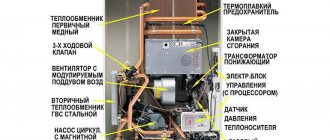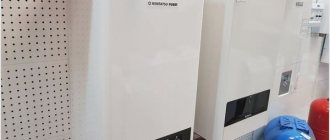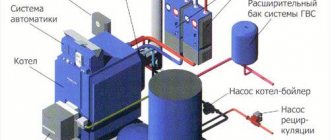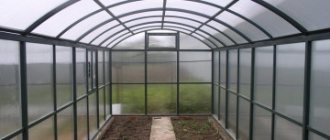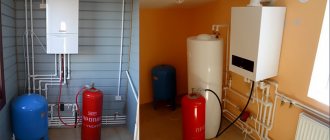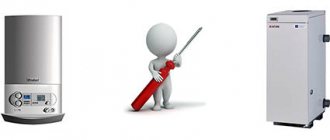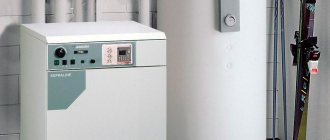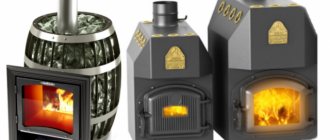The ability to replace a standard heating system with a propane gas boiler can be very relevant if access to main fuel supply systems is impossible for one reason or another. The operating principle of such equipment differs only in the level of pressure in the system and the method of fuel supply. Accordingly, almost any boiler model can be converted to operate on liquefied gas. And if the technical data sheet of the product indicates the possibility of connecting to gas-cylinder equipment without changing the design, you won’t have to spend a lot of time and effort on installing it and putting it into operation.
Which boilers can be converted to work with liquefied gas?
Propane boilers are produced by both domestic and foreign manufacturers - in most cases we are talking about universal models that are capable of adapting to different pressure levels in the gas pipeline when changing the automation settings. But, if desired, you can convert standard equipment with a main connection to run on liquefied fuel. To do this, you will need to replace the nozzle or the entire burner.
It is important to remember that conversion from main to autonomous gas supply is not possible in all boiler models. A necessary condition for its implementation is the ability to operate the equipment under pressure of 3 - 4 Mbar. Another important point concerns the operation of the gas valve - in a number of models it has to be replaced completely, since the throughput of this unit when operating on LPG should be 1.8 - 2 m³/hour.
The optimal solution for converting to supply gas not from main systems are condensing boilers - their efficiency in this case will be much higher, and fuel consumption will be reduced by 20%. It would be nice if all the components necessary for the conversion are included by the manufacturer in the delivery package. Purchasing a replacement burner may not be economically viable - on average, its cost is up to a third of the total price of the boiler unit.
How to make a conversion?
In order to convert conventional gas heating equipment into a propane boiler, you will need to perform the following steps:
- Replace the nozzles or the entire burner. In modern condensing models, sometimes simply replacing the cartridge is sufficient. All these actions must be carried out by professionals who have the appropriate approval - this is the only way to ensure safe operation of the system after connection.
- Install a reducer - a converter that reduces pressure. This step is necessary in order to adapt the boiler to work on LPG. If there are several cylinders, each of them can be connected to a separate reducer or a common converter.
- If necessary, replace the gas valve.
- If you plan to connect from cylinders, you should take care of installing a mating ramp that allows you to connect them into a single system (up to 10 containers at the same time). In this way, it is possible to maintain a stable pressure level in the system, reduce fuel consumption and reduce the frequency of refueling.
- In electronically controlled boilers equipped with a fuel type switch, it is also necessary to set parameter G31 corresponding to propane (G20 is set by default).
In any case, regardless of whether you are connecting gas equipment or planning to supply fuel from a gas tank, only professionals can carry out installation or re-equipment of existing equipment. Otherwise, it will be impossible to guarantee the safety of its operation.
How to calculate the number of cylinders in the system?
Fuel consumption if propane boilers are used is important. It’s one thing if you use a gas tank with a capacity of up to 6000 liters, one refill of which with a consumption of 20 liters per day will be enough for almost a year of uninterrupted operation. The same fuel consumption will look completely different when using cylinders. Taking into account the capacity of one tank equal to 40 liters, a double-circuit boiler will consume up to 120 liters in a week. That is, the expense will be quite noticeable. And to avoid frequent refueling or unexpected shutdown of the fuel supply, you should make sure that one refueling is enough for at least a month of uninterrupted operation.
To do this, cylinders are combined into groups - according to standards, the number of tanks in them can reach 15 units. But, most standard ramps are designed to connect up to 10 containers at once. They are connected through independent gearboxes or one common pressure converter - according to the main and backup circuits, within which the fuel consumption in each set is controlled. As soon as the pressure in the system drops below certain values, the installed fittings will open access to gas supply from additional tanks, thus ensuring safety during operation of the equipment.
Fuel consumption can be reduced if a system with automatic adjustment is used. In this case, it will be possible to configure different fuel consumption modes taking into account seasonal factors and atmospheric temperature indicators. For example, if the average temperature in the house is maintained at +9 ºС during the absence of owners, the consumption will be less than one cylinder per week.
Installation equipment
To install the heating system you will need:
- a gas boiler;
- burner for liquefied (cylinder) gas and the gas cylinders themselves;
- shut-off valves and gearboxes.
Burners for bottled gas differ in their configuration from conventional ones, and are usually included in the standard configuration of gas boilers. If necessary, they can be purchased separately. Shut-off valves and the necessary gearboxes can be purchased from the company or directly at cylinder refilling stations.
Connection
A cylinder or group of cylinders is connected to the boiler through a reducer with a throughput capacity of about 2 m3 / hour. Gearboxes for home stoves are designed for lower throughput - they are not suitable for a heating system. The gas tank system may have one common reducer or a separate regulator for each cylinder. The second option is more expensive, but this is what the experts recommend - separate gearboxes provide maximum safety.
Liquefied gas cylinders cannot be installed outdoors: the cold will cause a decrease in pressure, and the heating pad may refuse to work. The ideal installation location is a warm, ventilated area. It is important to remember that bottled gas is heavier than air, and if it leaks, it will pool at the bottom, increasing the likelihood of an explosion. Therefore, the room should be chosen separately from the living rooms. There should be no basements or subfloors in it!
Gas cylinders are connected to the boiler burner using a metal corrugated pipe - this reduces the likelihood of gas leaks due to system vibrations.
Flow adjustment
With the help of automatic sensors and correct settings, you can reduce propane consumption rates by 3-4 times. If we are talking about a country house, then the gas consumption will be even less: during the period of absence of people, the automation will maintain the temperature at 6-9 ° C, which will reduce the propane consumption to 0.7-0.8 cylinders per week. Heating a building with liquefied gas is not the cheapest option, but in some cases it is the most optimal if there is no problem with the delivery of cylinders.
Features of operation
Propane boilers operated with a connection to a gas holder require practically no additional attention - it is enough to regularly replenish fuel reserves. But in the case of gas-cylinder equipment, it will be necessary not only to monitor the level of energy consumption, but also to refill the tanks (and no more than three cylinders can be transported to a gas filling station at a time), as well as to ensure conditions for their safe operation.
According to safety rules, it is prohibited to install gas cylinders in rooms where there are heating devices.
. Moreover, to ensure the highest level of safety, they should be placed in a special metal cabinet equipped with a thermal insulation circuit - to prevent the containers from heating up in hot weather and freezing when atmospheric temperatures drop.
Regulations require that containers that are filled but not connected to the system be stored in a separate room or building, at a distance of 10 meters or more from an operating heating system. Ventilation is required - in this case, in the event of a leak, it will be possible to avoid the formation of explosive compounds in a concentration sufficient for accidental detonation. To avoid the formation of corrosion on tank bodies, they should be regularly inspected and provided to gas service employees to certify the tightness of the body at least once every four years.
TYPES OF PROPANE GAS BOILERS - DEVICE AND PRINCIPLE OF OPERATION
Despite the constant increase in prices for all energy sources, gas heating remains the most economically justified, especially given the constant increase in the construction of private country houses. Gasification of the most remote settlements, the laying of gas pipelines, has not yet spread everywhere, so often owners, for example, of country houses, who want to organize convenient heating and a comfortable environment in them, wonder how this can be done. A propane gas boiler will help solve this problem perfectly if you purchase and install the equipment, carefully following all the necessary installation requirements and operating instructions. There are currently enough household gas boilers on sale, powered by household gas cylinders or gas holders.
The use of autonomous gas supply often turns out to be more efficient (due to a constant fuel pressure) than main natural gas, and allows you to create a full-fledged home supply system - heating, hot water supply, the possibility of hassle-free cooking, even the use of electricity from a gas-fueled generator, that is maximum living comfort.
Modern equipment for operation from gas cylinders (GBO) ensures trouble-free and safe operation of autonomous heating in the power range of the units used from 1 to 120 kW, and Rostechnadzor requires mandatory registration of only bottled gas supply systems with a power requirement of 100 kW or more. The high efficiency of propane gas heating boilers and the ease of transition of bottled liquefied fuel into a gaseous state contribute to the fact that the use of this heating equipment is becoming increasingly widespread and in demand.
Design and operating principles of propane gas boilers
Externally, a gas boiler running on propane is quite compact and has a standard rectangular shape. Its device consists of the following main elements:
- burners (or rather, two – pilot and main);
- heat exchanger;
- expansion tank;
- circulation pump;
- fan (if forced air supply is necessary);
- automatic security and control.
According to the operating principle, propane gas boilers are no different from equipment powered by gas supplied through the main pipeline. To ignite the pilot burner (constantly burning wick), a piezo ignition device is used, then when gas is supplied to the working main burner, heating of the heat exchanger begins.
The guarantee of safety and control of the boiler operation is provided by automation; the following elements must be included in this system:
- blocking thermostat;
- flame sensor (responsive to blowing out the burner);
- a device that blocks the gas supply in the event of a power outage;
- a blocker that turns off the boiler when the gas supply is stopped;
- traction control sensor;
- controller for the presence of water in the system pipeline.
Types of propane heating devices
Functionally, boilers that operate by burning cylinders, just like other heating devices, are divided into:
Based on the location (method) of placement, these devices include a gas wall-mounted propane boiler and a similar one, but floor-mounted. Floor heating devices have more power, but at the same time they are much larger and more massive, and more expensive. Wall-mounted equipment is smaller in size and weight, more compact, and does not always need to be placed in a separate room.
Based on the principle of operation and the method of removing combustion products (smoke), boilers operating on liquefied gas are available in two types:
1. With an open combustion chamber, this design uses an atmospheric burner that uses air from the room (natural ventilation, similar to the operating principle of a fireplace). A boiler like this requires a vertical chimney, reliable ventilation and an opening for fresh air.
2. With a closed combustion chamber, which uses a forced-air burner, a forced supply of air into the boiler using a fan (turbo-blowing) is required, as well as a coaxial chimney, which provides protection against smoke penetration into the room and air supply in the required volume).
The main difference between installations that use liquefied gas is the use of a special burner, which has a smaller diameter (compared to the nozzle of a conventional boiler for main gas) and nozzles. The reason for using a different burner design is the difference in gas pressure; for liquefied gas it is much higher; some models provide an oxygen supply regulator to bring the gas-air mixture to a certain oxygen content level.
When starting to select a boiler, you should correctly calculate its total power, taking into account the heating requirement of 1 kW per 10 m? living space with ceiling heights from 2.6 to 3 m.
Most models of modern boilers, single- and double-circuit, can be converted from running on main gas to liquefied gas from a cylinder or gas holder with little time and money.
Installation of propane boilers
Before proceeding with the installation of equipment, you should calculate the possible consumption of liquefied gas when operating a gas boiler on propane, and decide what is better to use, a comb of cylinders or a gas holder, the capacity of which can be up to 6000 liters.
Ultimately, the overall autonomous gas supply system for a home, designed for boiler operation, must include the following important elements: 1. A vertical or horizontal container in which liquefied hydrocarbon fuel is stored, located underground or above ground. 2. Evaporation unit (if the storage facility is located underground, this device is not required, since gas evaporation occurs naturally). 3. Condensate collector - a device for collecting condensate, unevaporated and liquefied gas residues settled in the gas pipeline. 4. Base inlet - a connecting element between the underground part of the gas pipeline and above-ground communications. 5. An external gas pipeline (preferably underground to prevent freezing) and an internal one, passing through the house to the boiler. 6. Reducer (pressure regulator) that regulates gas pressure. 7. Fuel level indicator and gas pressure indicator in the tank. 8. Gas analyzer and shut-off valve to warn of gas leakage in the room. 9. Gas-consuming equipment, this can be not only a boiler and stove, but also a gas electric generator.
Advantages of boilers using liquefied fuel
The use of liquefied gas for heating and the installation of propane boilers for this purpose has obvious advantages: 1. Availability of use in the absence of the possibility of connecting to a gas main. 2. Low price compared to other types of fuel, and as a result - efficiency and cost recovery. 3. Environmental friendliness of the use of liquefied gas, since during its creation a thorough cleaning is carried out at the same time. 4. High-tech automatic safety control – a guarantee to eliminate the possibility of an explosion. 5. Ease of transportation of cylinders. 6. High efficiency of propane boilers. 7. Propane cannot be dissolved in water, which means it cannot pollute the surrounding environment. 8. The possibility of using liquefied hydrocarbons not only for heating and domestic use, but also for generating electricity. 9. Safety of use (compared, for example, with methane), since propane is a non-explosive substance. 10. Stability of fuel pressure indicator. 11. Reliability, simplicity and durability of gas equipment.
Despite the obvious advantages, this heating method also has some disadvantages: 1. The need to regularly check and clean the jets, which tend to become clogged with soot from low-quality fuel. 2. Equipment connection, repair and cleaning - only with the participation of specialists. 3. Some elements of the heating system require electricity, which means that if it is absent, the boiler will stop working. 4. Propane has virtually no odor, so in the event of a leak, the malfunction may not be immediately detected. 5. The absence of odor necessitates the installation of a propane gas sensor (gas analyzer).
Conclusion:
Subject to all safety requirements and high-quality installation and connection of gas equipment, the use of propane boilers is effective, economically feasible and affordable.
The massive construction of suburban housing, the adaptation of dachas for year-round living, and the desire to civilize rural life made us think about an alternative to solid fuel for heating. One of the most suitable options for this turned out to be a propane gas boiler.
He solved one of the troublesome problems of a country lifestyle - connecting a country house to the gas distribution network.
Thus, propane has successfully replaced wood, coal and electricity as a heating source. A modern gas boiler for heating has become an attribute of many homes outside the city.
This popularity of cylinder household gas appliances is due to the significant advantages of heating houses using propane.
First of all, this is explained by the fact that:
- Due to the rise in price of natural gas, the price difference between it and propane has become insignificant.
- Gas heating is possible where natural gas is not centrally supplied.
- The device, burning liquefied gas, emits only carbon dioxide, which is converted into oxygen by plants.
- Modern safety systems for such devices practically eliminate a gas explosion and immediately stop its supply to the boiler in the event of a malfunction.
Jets for a gas stove: bottled gas and natural gas - the difference, how to replace
Most gas stoves can operate on both natural and liquefied gas. To do this, the manufacturer supplies the devices with two types of jets.
Typically, household appliances are initially configured to connect to the gas main. To convert it to bottled gas, you need to change the nozzles.
If this is not done, the stove will not work correctly, which is dangerous for users.
How to convert a gas stove to bottled or natural gas
Natural gas, usually NG G20, is supplied to the kitchen from the central gas supply system, which is supplied to the device at a pressure of 20 mbar. Liquefied gas is used for cylinders, the most common is LPG G30.
It enters the device at a pressure of 50 mbar. The combustion of gas-air mixtures is not the same due to differences in composition and pressure. To level the flame and prevent the appearance of soot, jets of certain sizes are installed in the burners.
The jet (nozzle or nozzle) is usually made of bronze or brass. It looks like a threaded bolt, but only has an internal hole through which fuel is supplied.
The larger it is, the more gas flows through it. At the end of the nozzle there are numbers stamped out that indicate the diameter of the hole in hundredths of a millimeter.
For example, the number 75 means the hole diameter is 0.75 mm, and the number 115 means the diameter is 1.15 mm.
The size of the hole depends on the type of gas and the power of the burner. Since the pressure of liquefied and natural gas is not the same, different sets of nozzles have been developed for them. For bottled gas, nozzles with a smaller diameter are used, since its pressure is higher than that of natural gas.
Each burner (small, medium, large, oven) has its own jet, which corresponds to a number determined by the manufacturer. The smaller the burner, the lower its power. For its operation, less gas-air mixture is needed, which means that the diameter of the hole should be small.
Reference. Jets from different manufacturers may differ in shape, configuration and external thread diameter.
Nozzles are replaced if it is necessary to convert a gas stove from natural gas to liquefied gas and vice versa. But this is not the only reason. Jets are changed if:
- the fuel burns unevenly and the stove smokes during operation;
- the flame hisses and comes off the burner;
- the color of the flame is not blue, but yellow-white with red highlights.
These signs indicate that the gas stove has unsuitable nozzles. When the equipment does not work correctly, it is recommended to replace not just one injector, but the entire set. When switching to bottled gas, this is even necessary.
The differences between nozzles for natural fuel and nozzles for cylinders are as follows:
- shortened bolt body;
- fewer threads;
- increased hole diameter.
Manufacturers usually supply household appliances with two types of nozzles. But if they are not there or the device was purchased a long time ago, the jets can be purchased in the store or ordered on the manufacturer’s website.
Before purchasing, you need to determine what hole diameter is needed. It is important to approach the choice of nozzles for bottled or natural gas responsibly, since the safety of users depends on it.
When the gas from the nozzle flows crookedly, some of it accumulates under the hob. This may cause an explosion. The technical data sheet for household appliances contains data on jets for central gas supply and cylinder.
If it has been lost, you can find it on the Internet by indicating the brand of the device.
It is not recommended to change the dimensions of the jet holes yourself (try to drill them out or reduce them). Is it dangerous.
The ratio of hole diameters (in mm) to different types of fuel is given in the table.
| Burner type | Gas type (pressure) | |||
| NG G20 (20 mbar) | LPG G30 (50 mbar) | NG G25 (20 mbar) | LPG G30 (30 mbar) | |
| Small burner | 0,75 | 0,43 | 0,70 | 0,50 |
| Middle burner | 0,92 | 0,55 | 0,92 | 0,65 |
| Large burner | 1,15 | 0,60 | 1,15 | 0,75 |
| Oven burner | 1,20 | 0,65 | 1,15 | 0,75 |
| Grill burner | 0,95 | 0,60 | 0,95 | 0,65 |
When converting the stove to liquefied gas, it should be taken into account that not only the nozzles are changed, but also a reducer is installed. It is used to regulate the pressure of incoming fuel.
What is the fundamental difference between a jet for bottled and natural gas?
The main difference between jets for a gas stove for bottled gas and natural gas is the caliber of the hole. Since the pressure of liquefied gas is higher, the diameter of the holes is smaller.
Required Tools
Replacing jets should be entrusted to gas service specialists who have the necessary knowledge and qualifications and will be able to correctly adjust the gas supply when switching to another fuel. It is not recommended to remodel a gas stove yourself.
If the user decides to change the nozzles with his own hands, he will need the following tools:
- crosshead screwdriver;
- set of open-end and ring wrenches.
How to change nozzles on a gas stove
First, the stove is disconnected from the gas, if it was connected. After this, they proceed according to the following algorithm:
- Remove the top cover of the gas stove by unscrewing the screws to get to the burner.
- Then they find the latch, squeeze its ends and carefully remove it. After this, the tips with nozzles are removed from the traverse with burners.
- The tip is released from the socket and removed from the gas pipeline tube. The o-ring is removed from it and placed on the tube.
- Use a socket wrench to unscrew the jets counterclockwise. New ones are installed in their place.
- Carry out reverse installation. The accuracy of reassembly determines how smoothly the burner will burn.
It is easier to change modern models of gas stoves to use a different fuel. To gain access to the burner, only the grates with burners are removed. Then remove the tips and install new nozzles.
Replacing the jets in the oven is carried out as follows:
- open the oven door and the lower compartment of the device;
- pull out the floor of the oven compartment;
- unscrew the burner fastenings;
- carefully, so as not to break the thread, unscrew the nozzle (it is located on the left in a special housing);
- install a new nozzle and reassemble.
If the jet has become stuck during operation, unscrew the three fastening screws and remove the left side wall. Using a 17 wrench, unscrew the nut and move the pipeline to the side.
Then unscrew the two screws that secure the nozzle body to the wall. The stuck thread is treated with WD-40 or kerosene and the nozzle is unscrewed.
How does such a gas boiler work?
Fundamentally, a gas boiler that uses liquefied propane for heating is not much different from equipment that runs on gas coming from a gas pipe. Outwardly they are also similar. Recently, equipment has appeared with a steel casing of a more advanced design, different from the traditional rectangular one.
Mounted inside this casing are:
- Burner.
- Heat exchanger.
- Control electronics.
- Adjustment devices.
Rice.
1 The gas entering the burner ignites and heats the heat exchanger installed above the burner. Such a burner is ignited by electric ignition or, like a conventional gas water heater, by a constantly burning small gas wick.
The propane gas boiler is manufactured in single-circuit and double-circuit versions. In the first case, hot water is supplied only to the heating system. In the second - both for heating and taps for hot water. It is characteristic that double-circuit boilers are considered one of the most economically feasible devices in autonomous heating systems.
Propane-butane gas boilers can be installed on the floor or mounted on the wall.
Rice. 2
What you need to know about such a boiler
Heating equipment using propane boilers has proven to be quite acceptable for autonomous heating. Such devices are compact, easy to use, and environmentally friendly. They have excellent efficiency. They work no worse on liquefied gas mixtures than on natural gas.
However, in order to use such a heating product with maximum efficiency, you need to know some of its features, in particular:
- here the gas burner with nozzles has a diameter 2-3 times smaller than in conventional gas boilers due to the significantly higher gas pressure from the cylinders.
- such a boiler must receive more oxygen than a conventional one, so an oxygen regulator should be used.
- special automation ensures the safety of using the unit when heating, shutting off the gas in case of danger of an accident.
- Single-circuit heating boilers mounted on the wall are very sensitive to low-quality gas, which is why their nozzles (nozzles) become clogged and require professional cleaning.
Rice. 3
Before purchase and installation
Before buying a propane gas boiler, you should consult with professionals. The fact is that such heating installations are considered explosive, despite all their wonderful advantages. Therefore, when choosing such gas equipment and during its installation and operation, you should have an idea of the technological conditions of their operation and installation.
This will add peace of mind and confidence when operating such a boiler. Therefore, having decided to install independent heating at home using propane, it is necessary to organize the receipt of several necessary documents. Specialists from the gas company can also help with this and will install and set up the boiler.
The following requirements must be taken into account:
- It is mandatory to equip the boiler with a high-quality exhaust to remove combustion products and remove harmful impurities in gas vapors.
- if the wall-mounted apparatus has a closed combustion chamber, a coaxial type chimney must be installed for it, which, using forced draft, will ensure the supply of oxygen to the wick and a stable flame on the burner.
- Gas storage must be organized in a separate room.
- in case of a significant volume of gas consumed, provide for its storage in a gas holder - a metal tank for accumulating and storing gas, located away from the house.
Rice. 4
Save gas
Heating a home requires a significant amount of liquefied gas, so saving it becomes important. And this despite the fact that heating costs with electricity would be higher. After all, even for a well-insulated house with an area of about 130 sq.m. A gas cylinder with 50 kg of gas will last for 2-3 days. And with a double-circuit boiler, which will provide a room temperature of 22-23 degrees per week, 3-4 standard containers will be required.
It is necessary to use all possibilities for economical heating. When purchasing equipment, you should pay attention to the fact that it has a room thermostat and a temperature sensor. This will significantly reduce fuel consumption in the absence of people in the house or unexpected warming. To do this, it is enough to adjust the boiler so that it starts working a couple of hours before you return from work and turns off before leaving home.
With the help of gas specialists, check the condition of various seals and connections on the boiler. Even a loose gasket or a loose nut can significantly increase gas consumption.
Some experts believe that an automatic condensing gas boiler, which has a closed combustion chamber and correctly calculated power, has good consumption indicators.
Sometimes, to save money, some craftsmen advise remaking conventional boilers. It should be remembered here that such alterations on your own are categorically unacceptable. Such work can only be carried out with special permission.
Regions located far from centralized gas supply have found an alternative replacement for themselves in the form of what is also called LPG - liquefied petroleum gas.
Propane-butane has its advantages and disadvantages, which will be discussed in the article.
Propane-butane in liquefied form can be stored in large quantities, and when burned, it releases 3 times more energy than at the same consumption.
LPG can be stored in ordinary cylinders, or in gas holders - these are large-capacity tanks that are installed underground and can hold several thousand kilograms of gas. All these advantages did not cause its high cost, so even at the price, propane-butane is more profitable than natural gas.
For heating residential and industrial buildings located far from the centralized gas supply, gas boilers that burn LPG are widely used. Propane boilers with a double circuit have become especially popular.
Application of propane boilers
The main motives of the owners of such units are:
- Complete independence from central heating or gas supply.
- Launching autonomous heating with the expectation that over time it will be possible to switch to central gas supply. After all, the same boiler can operate on different types of fuel. You just need to make a replacement. All the parts necessary for this are on sale. And in some cases, all parts come as standard when purchased with the boiler itself.
Types of propane boilers
By functionality:
- - These are boilers that can only provide room heating. If the room requires hot water supply, then it is necessary to install an additional heating tank.
- - these are boilers that are capable of providing both heating and hot water, without requiring the installation of additional equipment. The mode of such boilers can be configured as follows: in the cold season, “both heating and DHW”, and in the warm season – “only DHW”.
By installation method:
- - these are boilers that are installed on a special foundation or simply on the floor; they are usually heavy and large in size, but at the same time they also have great power.
- Hanging boilers are lightweight boilers, weighing up to 100 kg, which are hung on the wall, have low power and take up little space.
Hanging gas boiler
By type of traction:
- Propane boilers with natural draft are boilers that are provided with a high chimney through which flue gases are removed, and combustion is supported by the air in the room where the boiler is installed, which leads to a lack of oxygen in the room.
- A forced draft boiler is equipped with an additional fan to remove combustion products, which eliminates the need to build a high chimney; it is enough to just make a hole in the wall and install a coaxial pipe into it. It represents one of which smoke comes out, and the other brings in the air necessary to maintain the combustion process.
Advantages of propane boilers
Propane boilers have the following advantages:
- Cost-effective compared to diesel and solid fuel boilers.
- Easy to use.
- Compliance with environmental requirements.
- Both partial and full automation are possible.
Disadvantages of propane boilers
Propane boilers have the following disadvantages:
- Since propane is heavier than air, it tends to accumulate at the bottom of the room, which entails an increased risk of explosion. Therefore, you must comply with all the requirements for the operation of such boilers.
- The need to have special equipment for storing gas in sufficiently large quantities (gas holders), since gas cylinders cannot provide a sufficient amount of gas.
- For boilers with an internal combustion chamber, forced draft is required.
- Single-circuit boilers are highly sensitive to low-quality fuel - the jets quickly become clogged.
Before purchasing a propane boiler, it is necessary to make some calculations in order to select a boiler of the required power in accordance with the size of the heated area.
On average, the calculation is 2 kW of power per 10 sq. meters of heated area, if the height of the room is 3 meters. It is also necessary to calculate the heat loss of the room, but it is better to entrust this to a specialist.
The table shows approximate values of the required boiler power depending on the heated area, as well as fuel consumption.
| House area, m² | Boiler power, kW | Maximum fuel consumption, kg/h |
| 100 | 5-12 | 3,2 |
| 130 | 6-16 | 4,7 |
| 160 | 6-20 | 6,0 |
| 200 | 7-24 | 7,6 |
| 220 | 8-25 | 7,9 |
| 270 | 10-32 | 8,9 |
| 370 | 18 and over | from 14.0 |
Gas boilers are in great demand in areas with little development of centralized gas supply, as they can ensure completely autonomous operation of the heating system. It is only necessary to periodically refill the gas tanks .
When independently installing an autonomous gas supply to any home, you need to take into account many very important nuances related to the maintenance and maintenance of the line and extremely accurate calculation of the power of your installed equipment. In order to ensure maximum thermal output and efficiency of the system, it is necessary to correctly select and connect a device operating on bottled gas. Many manufacturers offer such gas heating boilers for heating rooms using a cylinder. However, in order to choose the right device that suits your space, you need to listen to the advice of experts.
What automatic settings are there?
Currently, the market offers consumers a wide selection of control devices. Therefore, you need to know what automation systems for home heating systems generally exist, and what to give preference to.
Room thermostat
According to installation criteria, there are:
- Wired thermostats. The advantage of this type is the ability to supply power up to approximately 50 meters via wires.
- Wireless thermostats. The advantage is that it is not necessary to create holes for the wires. However, they have a significant drawback - reinforced concrete walls reduce the signal power.
According to functionality they are distinguished:
- Simple thermostats. They retain the desired level of warmth.
- Programmable thermostats. Such devices are capable of setting a certain number of degrees for a whole week in advance (the period depends on the model) with maximum accuracy down to seconds. The advantages also include cost savings due to weekly programming.
Thermostats are also distinguished:
- Electronic thermostats. The kit contains three components: temperature sensor, signal transmitter, relay. The main advantage of the device is the maximum accuracy of the equipment. Don't forget ease of use.
- Mechanical thermostats. The basis of the devices is the ability to change properties under the influence of temperature levels. Due to temperature changes in the gas membrane, a circuit is closed or opened, causing certain mechanisms to work.
- Electromechanical thermostats. The mechanism of the device is much simpler than an electronic one. The main element is the relay. The node looks like a tube, which is filled with a special substance that reacts to temperature. If the boiler heats up, the substance expands; similarly, when the boiler cools, the substance contracts. And the drive, dependent on the substance, regulates the temperature thanks to an electrical circuit.
Connection can be made to:
- Kotlu;
- To the pump;
- Servo drive;
Thermal head
This is a thermostatic element that, under the influence of the external environment, slightly opens or closes the radiator. An inexpensive type of automation for heating a home. A significant advantage is that the thermal head is very convenient for local heating, and there are also significant cost savings. Of the minuses: firstly, the adjustment occurs according to standards consisting of abstract numbers, not degrees. Secondly, the sensor measures the degree of heat around the installation, but not the room, which reduces the accuracy of the device.
Weather-compensated automation
The design of weather-dependent automation for heating a house is simple: as the weather outside decreases, the temperature of the coolant increases. However, a weather-dependent installation has a very significant drawback - the system sometimes does not have time to adapt to the temperature, and, therefore, the effect is delayed. The especially mentioned disadvantage manifests itself if an addition is connected - heated floors. The disadvantages include the fact that the devices do not operate entirely correctly, approximately, so the change is noticeable only during seasonal climate changes. It is worth noting that the prices for the unit are relatively high. But the units will be very convenient in production, large-scale houses (over 500 square meters).
The principle of operation of a gas boiler using bottled gas
An autonomous modern gas boiler for working on gas cylinder structures is very easy to install. The connection diagram here is the same as for a boiler with a main pipe. The difference is that during installation it is necessary to take into account increased fire safety regulations.
A significant drawback when using household cylinders for boilers is the need to periodically refuel them. On average, one container lasts for three aphids for two days. After this, you need to disconnect the cylinder and take it to a refueling station.
Connecting more than one cylinder to a single network will reduce the frequency of trips to the gas station. Modern boilers make it possible to connect from two to five containers simultaneously. In this case, the cylinders are not connected directly. To do this, a special reducer is connected, which allows you to maintain a stable pressure necessary for the uninterrupted operation of a gas heating boiler operating on bottled gas.
The operating diagram of the connected node is as follows:
- The ramp is a two-arm collector that divides the containers into two subgroups;
- The initial gas intake occurs from the main group;
- In the event of the end of the propane gas in the cylinder, the ramp automatically transfers the operation of the boiler from the reserve tanks and issues a mechanical signal.
When refueling is completed and the containers are connected to the manifold, the main working group of cylinders is automatically switched on.
Do-it-yourself replacement of gas stove nozzles
A small part of any gas stove, without which it cannot work properly, is the nozzle.
They have to be changed very rarely, and only in the case when the incoming blue fuel is changed to a liquefied version from cylinders instead of stationary gas.
You can replace the jets in a gas stove with your own hands, but to do this you need to know all the nuances of dismantling.
The principle of operation of the nozzle
The classic solution for kitchen stoves is the gas supply system. It includes the burner, transport channels, shut-off valves and, in fact, the burner itself. Regardless of the model type and price segment, these elements remain unchanged.
The volume of supplied gas and its pressure fall on the shoulders of the shut-off valve and burner. This tandem is most often called a jet and an injector, where the first is part of the second. Both liquefied gas - propane (in cylinders) and natural gas - methane (pipeline) can be used as fuel.
For correct operation of the equipment, clearly adjusted gas supply proportions are required. That is, fuel must be supplied at a certain speed and in equal shares. This is precisely why a jet is needed in the system.
In addition, it is necessary to select injectors taking into account the type of fuel. For example, an element designed to work with propane will smoke dishes and emit harmful substances if installed in a system operating on methane.
To maintain the required volume of gas and pressure, an adjustable hole is provided in the nozzle. On new plates, the elements are calibrated to optimal/universal parameters. The latter are calculated based on the power of the equipment and the maximum rate of fuel combustion.
System Features
Jets are very similar to regular bolts: a hex head and threads. Among others, the element is distinguished by a small hole in the central part. The diameter of the nozzle is calculated based on the type of gas, the power of the stove and the characteristics of the fuel supply system.
Jets for gas stove
With equal power ratings of equipment for propane, the hole size is slightly narrowed, while for methane it is noticeably wider.
If you install nozzles for natural fuel on a burner running on bottled gas, the tongues will be much longer than they should be.
On the plus side, a specific noise will appear, and the flame will turn orange. Replacing the part with an element with a narrower nozzle will help here.
Jet sets
Almost all jets have the same slot size - 7 mm. On large industrial equipment or, conversely, on mini-plates, you can find non-standard format parts. The length of the jet also depends on the type of fuel. Elements running on liquefied gas are slightly longer than those running on natural gas.
Recommended hole diameters for different types of fuel:
Most manufacturers equip their models with universal nozzles that operate on regular natural gas.
As a rule, models from the mid-price and premium segments allow you to regulate this moment, that is, switch the fuel type to propane and back using a nozzle.
If this is not possible, then the corresponding set of jets can be purchased at almost any specialized store.
The elements themselves are made of brass. They can easily withstand severe temperature changes, are resistant to corrosion, and at the same time durable. In addition, during cooking the jets practically do not heat up.
On old-generation equipment, these elements were combined: one part was made of brass (the nozzle itself), and the other part was made of aluminum (the base into which it is screwed).
In this case, when replacing, you must be careful not to strip the threads.
As for the thread pitch, in the absence of documentation, determining this is not so difficult. In stores you can find two standard sizes - 0.75 and 1.0 mm. With rare exceptions, there are non-standard options, but such exotic ones are suitable for the same specific equipment, not intended for domestic needs.
Almost all models are from 2009. and were previously equipped with jets with a pitch of 1 mm. Modern equipment is equipped with elements with a thread of 0.75 mm. It’s easy to find out exactly what pitch the part has: apply the old jet to the ruler. If the thread clearly follows every millimeter on the scale, then the pitch is 1 mm, and if it lags, then 0.75 mm.
Important! When switching equipment from methane to propane, you will need not only new nozzles, but also a gas reducer.
Possible injector malfunctions
Jets are quite reliable elements and can last for many years. They are changed, as a rule, in two cases: a manufacturing defect or a change in fuel type. For normal operation of the parts, it is enough to simply clean them of dirt.
Factors indicating clogged injectors:
- flames with a red-yellow tint;
- the burner often goes out;
- The flame intensity changes periodically;
- The burner is difficult to light or does not light at all.
How to connect a liquefied gas cylinder
Installing a gas boiler designed for autonomous heating with bottled gas is much easier than installing a heating system using mains fuel.
Experts have several rules regarding fire safety, use and reconfiguration of the device, as well as power output, which require strict adherence.
In view of this, independent installation of this unit is not recommended. It is better to invite a responsible specialist. The norms and rules for the correct installation of a cylinder are regulated by a set of fire safety requirements, which states that liquefied gas cylinders should not be located in the same room as the heating device.
Besides:
- Cylinders must be taken into an adjacent room or outside and installed in a special cabinet.
- Empty gas cylinders must be stored outside the building. It is best if you refill the containers immediately.
- If the cylinders that you installed in a cabinet outside freeze, you should insulate the storage using non-combustible thermal insulation.
- Heating containers or the cabinet itself with open fire is strictly prohibited.
- The distance between the gas cylinder and the boiler must be at least 2 m.
- Do not store propane cylinders near the boiler room.
- Storage of containers is permitted only in a specially equipped place located at a distance of no closer than 10 meters. It must have ventilation.
- It is also prohibited to use the basement for this purpose.
During the operation of cylinders, complete depletion of LPG from the container is not allowed. Every 4 years it is necessary to carry out certification of the tightness of containers and the integrity of their body.
Features and nuances of installation, connection rules
When performing installation, it is important to strictly observe and take into account a number of requirements. In principle, 80% of all work is performed in the same way as in the case of installing a conventional gas appliance, but there are some differences:
- Installation of a device that runs on LPG must be done in a room with an area of at least 8 m2;
- The ceiling height in the boiler room is not less than 2.3 m;
- The distance from any side (not the front) of the boiler to the wall is from 0.7 meters;
- The room must have high-quality natural ventilation, at least one opening window, and a wide passage.
Provided that all requirements regarding the selection, installation and connection of the heating device are strictly met, further operation of the device using liquefied gas will delight you with stability and safety, cost-effectiveness and operational efficiency.
Is it possible to convert the boiler to liquefied gas: rules for conversion
A conventional wall-mounted or floor-standing boiler from liquefied gas cylinders only works if certain connection conditions are met and conversion is performed. Reconfiguring the equipment is not necessary, but it is necessary to install additional fittings that will stabilize the gas pressure.
When choosing equipment that you plan to convert to run on liquefied gas, you need to pay attention to the technical documentation. Not every boiler can operate on LPG, so the technical specifications should be read carefully.
For proper operation of the LPG boiler during conversion, several important nuances must be observed:
- Replacement of the burner or nozzles is required due to the fact that gas-cylinder heating equipment designed to operate only on LPG is not available.
- In order to switch from mains gas to bottled gas, not only the burner changes. You will also need to change the cartridge.
- Liquefied gas is pumped into cylinders under pressure. This leads to its transition from gaseous to liquid. In order to convert it back, you need to lower the pressure. For this, a gearbox is used.
Some boiler models will only work correctly after replacing the gas valve.
Liquefied gas consumption
The amount of fuel spent on heating depends on the operating conditions of the device and its technical characteristics, usually power and efficiency. So, for example, according to the passport data, for the boiler JSC Zhukovsky AOGV-17.4-3 with a power of 17 kW with an efficiency of 90%, the consumption of liquefied gas is 0.7 kg/h or 1.3 l/h.
Knowing that the cost of refueling in 2021 is 17–18 rubles/l, you can roughly calculate the cost of heating a house over a certain period of time:
- per day (24 hours) – 1.3 × 24 = 31 l × 17 (18) ≈ 527–558 rubles;
- per month (30 days) – 31 × 30 = 930 l × 17 (18) ≈ 15810–16740 rubles;
- for a season (six months) – 930 × 6 = 5580 l × 17 (18) ≈ 94860–100440 rubles.
It must be taken into account that a 50 liter cylinder actually contains 40–42 liters of propane-butane mixture: about 15–20% of the free volume is used to increase the area of gas evaporation, and overfilling leads to a decrease in its production. This means that with a flow rate of 1.3 l/h, one cylinder is enough for approximately 1.5 days.
Which propane boiler is better to choose?
Not all equipment is suitable for using bottled gas boilers. And if you made a mistake when installing the device, then increasing the efficiency when operating an AGV, AOGV or gas tank is quite problematic. Your mini-boiler room will malfunction. Therefore, the correct choice of heating unit plays an important role.
The most economical and most suitable for operation on liquefied gas is condensing equipment. In this case, the operating time of the boiler on the cylinder increases on average by 15-20%.
To heat rooms, you should exclusively choose single-circuit boilers. For simultaneous heating of water, double-circuit. The best option is devices that have permission to connect to the cylinder. If you convert a conventional water heating unit, the fuel consumption will be higher. Along with the cylinder, boiler manufacturers offer all the necessary equipment for connecting the cylinders. But you can also purchase it separately.
Consumption calculation
The feasibility of switching to liquefied gas must be supported by economic conclusions. To do this, you need to know the volume of fuel consumed for a specific boiler model. This data can be taken from the equipment passport, since the amount of fuel depends on the operating mode of the equipment.
For an approximate calculation, you can use the following formula: W=Q/(qH*efficiency)
Where W is the volume of liquefied gas consumed per 1 hour of operation; Q – actual power of the heating system; qH – heat of combustion. For liquefied gas it is 10.175 kW/l; Boiler efficiency. For gas models it cannot be less than 0.92.
For example, you can calculate the amount of fuel consumed by a 24 kW system:
W=24*(10.175*0.92)= 2.56 l/h
If the boiler operates in this mode for 8 hours per day, the consumption will be 2.56 * 8 = 20.48 liters. Accordingly, per month: 20.48*30=614 l. For example, you can compare the required volume of liquefied gas for premises of various sizes compared to other types of fuel:
For an accurate calculation, it is necessary to take into account the actual heat loss of each room and the temperature conditions of the heating supply. To optimize costs, it is recommended to install heat sensors on radiators in each room and connect them to the heating programmer. The boiler power will be adjusted automatically, depending on the set operating temperature of the system.
How a propane gas boiler works (video)
The main advantage of connecting heating to LPG is the speed of installation of the equipment and the absence of strict standards that limit the consumer. There is no need to obtain an operating permit, and there is also no need to prepare design documentation, as happens with the main connection for natural gas boilers. However, this room heating system also has its disadvantages, of which there are also quite a few. The user must constantly monitor the condition of the cylinders and the amount of gas in them. The cost of gas is also not cheap, and in order to heat the room all season, you need to stock up on a considerable amount of money. And converting the boiler to use bottled gas will require quite a bit of capital investment. Replacing just the burner will cost you approximately 30-40% of the cost of the entire boiler. The need for the services of qualified specialists also requires significant costs, which are unlikely to pay off, given the high cost of gas.
